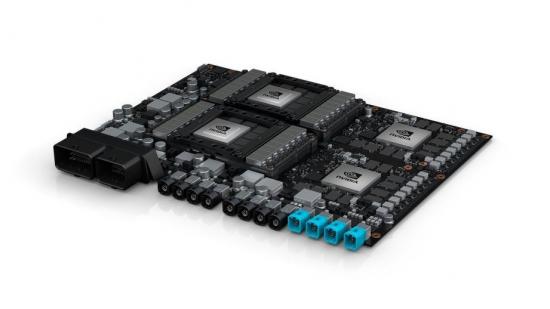Nvidia’s Jen-Hsun Huang wrapped up the keynote at Nvidia’s GTC Europe 2017 event yesterday, having surreptitiously displayed their next next-generation graphics cores. The star of the show this time around is the Drive PX Pegasus, a level five autonomous driving computer that demands more computational power than even the soon-to-be-released Nvidia Volta GPUs can offer.
The best graphics card demands the best gaming monitor.
Nvidia are world leaders in AI, and their Drive PX platform specifically targets the cutting edge in self-driving cars. At the top of the Drive PX stack will be the new Pegasus, an AI computer powered by two unannounced GPUs, our first look at the successor to the currently unreleased Volta. These next-generation GPUs are capable of driving automated cars that are as adept on the roads as their mushy human overlords.
The main aim of the Drive PX Pegasus is to allow level five autonomy to become a reality, and Nvidia already have a wide range of support from companies looking to include the Pegasus in their designs – from autonomous taxis to bulky self-driving lorries.
Vehicular autonomy is measured in five levels. Levels zero through four still require some form of human control along the journey, with level five offering full control over the vehicle under all circumstances in which a human would usually have control.

To reach the lofty heights of level five, the Pegasus needs to be capable of over 320 trillion operations per second, and hit upwards of 500W TDP. The Pegasus requires some serious computational power to deal with all the environmental stimuli it receives from onboard sensors, including up to 16 cameras, to keep the vehicle and its passengers safe.
This tech is supposedly ten times faster than its predecessor, the Pascal-powered Drive PX 2, and that could be good news for gamers… eventually. Nvidia are dominating the AI market, almost unanimously touted as the world leader in future development of AI and machine learning, and alongside Nvidia’s consumer graphics dominance at the moment. This may lead to Nvidia sidelining their gaming market, delivering only ‘good enough’ graphics performance improvements generation-on-generation while they focus on AI, because the competition simply isn’t forcing the issue.

So while gamers wait around for Nvidia to get around to launching their Volta-based graphics cards, they are already planning the release of their next-generation GPUs, with dev kits of the Pegasus arriving in mid-2018. While this ‘launch’ seems awfully close, it’s unlikely that any cars built with the Pegasus will be on the road anytime soon, possibly not even for years to come.
With a potential for release around the middle of 2018, the Drive PX Pegasus, and next-generation GPUs within it, confirm Nvidia are continuing to push AI and autonomous driving applications above and beyond the current generation consumer graphics cards by at least a few years. It may not be until this time next year that we have even the slightest idea regarding the next-generation graphics found in the Pegasus, and at this rate, we may have only just got our hands on Volta-based graphics cards anyways.
